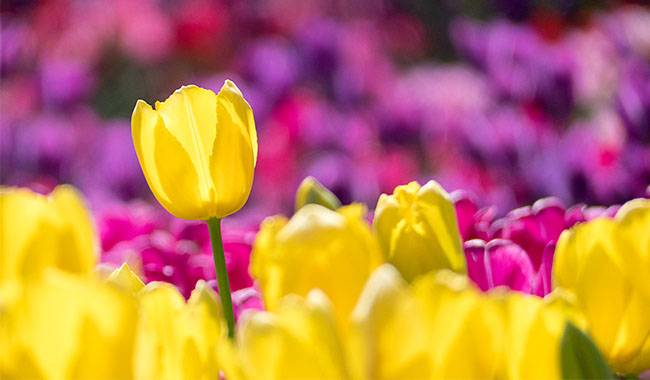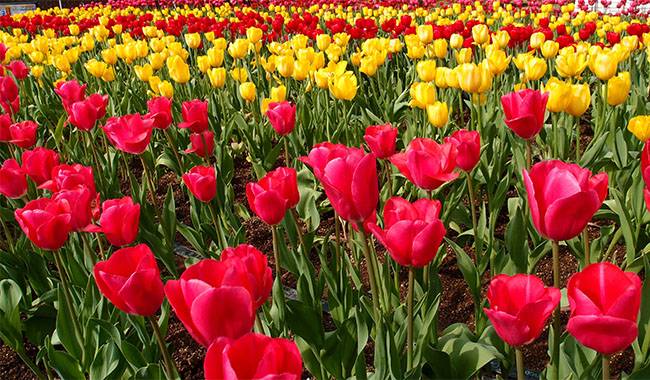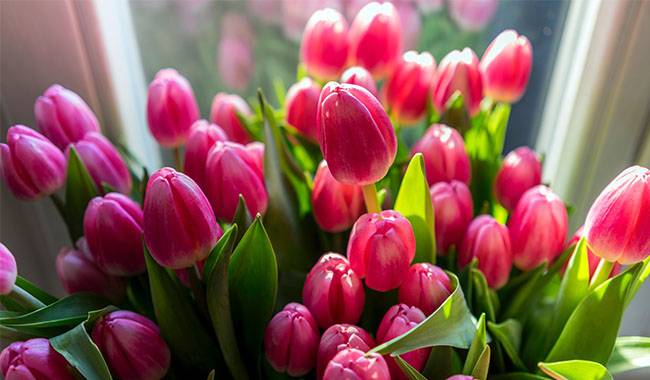
Tulips are one of our favorite spring flowers, and there is hardly a garden that doesn’t have them. But no matter how abundant the variety, we always want something new. I recently discovered dwarf botanical Tulips. Despite their petite stature, these cute little guys are not only as good as their taller counterparts but in some ways surpass them. In this Thumbgarden article, I’d like to introduce my favorite varieties of botanical Tulips to my fellow florists.
CHARACTERISTICS OF BOTANICAL TULIPS
Botanical Tulips is a special class of Tulips that includes natural species still growing in the wild in Central Asia, Iran, Turkey, northern India, and Eastern Europe. In addition, there are varieties and hybrids based on these wild species.
The class of botanical Tulips is mainly represented by dwarf cultivars that do not usually grow to 6-12 inches (15-30 cm) tall. Their flowers are also small in size, with goblets only 1-2 inches (2.5-5 cm) in height.
Botanical Tulips successfully combine the characteristics of cultivated and wild plants, so they look ideal in natural gardens, especially when combined organically in rockeries and wigwams.
Biologically, Botanical Tulips do not differ much from other Tulips’, so they have similar cultivation techniques. Most importantly, the successful cultivation of this type of plant requires loose, permeable soil and a good drainage system to allow excess water to drain away from the bulbs.
The location can be in full sun or a slightly semi-shady area. Botanical Tulips are grown at the same time as Classical Tulips, from mid-September to mid-October, with bulbs spaced 2-6 inches (5-15 cm) apart and buried to a depth of 3 bulb heights.

ADVANTAGES OF TULIPS PLANTS
The bulbs of these species almost always retain their complete shell and do not show any mottling. In general, plant Tulips are highly resistant to the various diseases that characterize bulb plants.
Most species of Tulips do not need to be dug up every year. They can grow in the same place for 5 years or more and flower each year. However, about every 3 to 4 years, it is best to dig up the bulbs and divide the nest. However, depending on their condition, some species may not need to be dug up at all.
Unlike safflower, which requires a lot of sunlight to open its flowers, the plant Tulips needs very little sunlight. Even on the sunniest of days, they flaunt their bright midribs.
Because of their diminutive stature, Plant Tulips are ideal flowering plants. They don’t need a sling in full light and look lovely in small pots, like living bouquets. They don’t take up much space indoors or on a windowsill.
Tulips varieties and their hybrids bloom early (late March/early April) and outgrow their larger-flowering cousins. These Tulips also suit any garden style. The beautiful foliage makes botanical Tulips attractive both before and during flowering.
Tulipa Shogun
Tulipa Shogun is my favorite variety of small Tulips. First of all, it has very bright lush bright orange flowers that are especially pleasing to the eye after winter. It is one of the most flowering plants Tulips. Its “goblets” can reach 2 inches (5 cm) and 4 inches (10 cm) when in full bloom! Dark purple stamens surround the pistil of the same color. The flowers have a very light scent, like classical red Tulips.
Tulipa Shogun has stunning foliage. It is purplish-red and covered with a distinctive fuzz when it comes out of the ground. Later the leaves turn green but still have a slight fuzz. This sets this tulip apart from most other Tulips with smooth leaves.
“Tulipa Shogun” is one of the most suitable for spring holidays. The plant acquires a miniature growth of 4-6 inches (10-15 cm) with additional light. How spectacularly large 2 inches (5 cm) flowers look on such a “dwarf”! Later, the stems can grow up to 10 inches (25 cm) high when the flowering period is over.
Another advantage noted by Tulipa is that this Tulip grows exceptionally well and does not require digging. As a result, the bright masses become lusher and lusher as they age.
Tulipa Tete-a-Tete
Tulips Tete-a-Tete is one of the few Tulips that belong to the peony family. Tulipa Tete-a-Tete has dense burgundy flowers with occasional green patches. Even when fully open in full sun, Tulips never lose their glassy shape and only slightly expose their brown centers.
These amazing Tulips are true babies, measuring no more than 4 inches (10 cm) in height. However, for such babies, the flowers of Tulips are quite large at 1-2 inches (2.5-5 cm). Therefore, Tulips does not seem to bear the weight of such a powerful pompom. However, the short flower stems are quite sturdy and do not bend to the ground. Furthermore, although the flower stems are about half the length of the leaves, the florets are not hidden in the leaves – these Tulips have very narrow leaves, similar to the green onions on feathers.
The scent of Tulipa Tete-a-Tete is delightful and deep, with a spicy aroma that is slightly bitter and slightly reminiscent of cinnamon. The intensity of the scent is medium, and you can only smell it when you deliberately smell Tulips. The petals do not fall off after fading, and the florets will dry out like miniature peonies.
This variety is a real charmer. It would make a perfect gift in the right pot. Its botanical name is “Pretty Tulips,” which is probably no coincidence. It may be hard to believe that this is a real live flower and not an artificial bouquet from a distance. It blooms very early in April.

Tulipa polychroma
Tulipa polychroma or Tulipa biflora is a very unusual Tulip that makes you want to look at it for hours! It is a great example. It has a really unique color that looks not like a brushstroke, but dust, like an artist painted it with pastel crayons.
The bottom of the flower is white, but several shades of blue and mauve can be seen outside the petals. There is a yellow spot at the bottom of the goblet, which becomes particularly bright when the flower is in full bloom. There are no shades of blue on the inside of the petals. The pistil is white, the anthers are bright yellow, and the petals are pointed, making the flower very similar to the safflower and lily of the valley.
When these Tulips first bloomed, it took me a long time to figure out what their wonderful fragrance was like. It seemed to absorb the scent of all the spring flowers and blooming orchards. However, for me, the most prominent scent in this bouquet was the lily of the valley. The scent of the double-flowered Tulips was quite strong but not overt. The flowers were strongest when they were half-open.
The flowers are not large in diameter, 1 inch (2.5 cm), but one bulb produces four or more flowers, two of which bloom almost simultaneously. This arrangement makes Tulips more reminiscent of the lily of the valley, giving the impression of light-colored lily of the valley flowers arranged in bunches. This tulip is an early flowering Tulips, which blooms in April.
Tulipa Persian Pearl
Tulipa Persian Pearl is another variety of Tulipa pulchella that grows mainly in the wild in Iran. Perhaps also because of its origin, this cultivar got the name “Tulipa Persian Pearl.”
Visually, the color of the petals is slightly lusterless with a grayish-green tinge, but also quite attractive enough to be called “Tulipa Persian Pearl.” However, when the flowers are fully open, their true beauty is revealed in the sunlight. The fully opened flowers have a deep purple-red color. The yellow color in the middle of the flower makes it even brighter and more intense. The flowers are up to 2 inches (5 cm) in diameter.
The flowering period lasts quite a long time for this variety of botanical Tulips. The flowers also have a delightful fragrance. It is most similar to apple and has a hint of exotic fruits. It may need a sling if grown in a lack of light. This little Tulip is a true gem of the vineyards and the Alps. The flowers grow slightly above the foliage.
Tulipa Alba Coerulea Oculata
Tulipa Alba Coerulea Oculata is probably the most unusual and exotic of the botanical Tulips. Its name (oculata) translates from Latin as “eye” for a reason. Like many Tulips, it has a contrasting spot in the center of the flower. But these Tulips have a very rare color: dark purple. The anthers and pistils are also dark purples.
The petals have a pure white base, so they look glossy, like they are made of porcelain. When juxtaposed with the snow-white petals, the purple center shows up as the dark iris and pupil of the eye. This makes the tiny Tulips look at us with expressive eyes. The goblets reach a height of 1 inch (2.5 cm). The petals are dense and sharp.
The scent is very faint and can only be detected when you hold the flower close to your face. It smells of roses and lily of the valley. It is still quite a rare collector’s variety, but lately, it appears more and more frequently on the market. And I highly recommend getting one of these wonders in your garden. It is very hardy: frost resistance to zone 3. Flowering time – from early spring to mid-spring (late March – April).
Tulipa batalinii Bright Gem
Tulipa batalinii Bright Gem is an interesting cultivar based on Tulips named after the botanist A.F. Batalin. In the wild, it is widely distributed in Europe. The variety has received a prestigious award from the British Horticultural Society.
The color of these Tulips is a warm orange with a slightly brownish crimson. However, the color of the petals of these Tulips may change as it blooms, also depending on the intensity of the light. For example, when there is no extra light, my Tulips turn a very interesting lime yellow. Planted outdoors in the garden, ‘Bright Gem’ may look like a peach or have some butterscotch flavor.
The plants are 6-12 inches (15-30 cm) tall, and the flower stems grow a little taller than the leaves. This plant is easy to grow and forms more and more flowering shrubs each year. It blooms in May.







